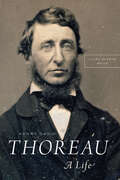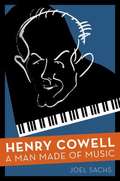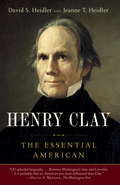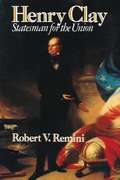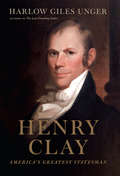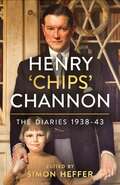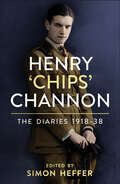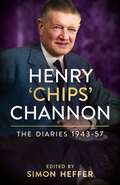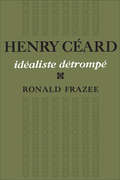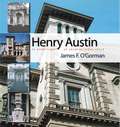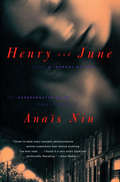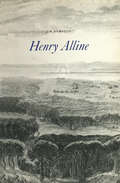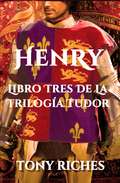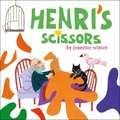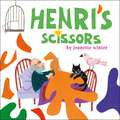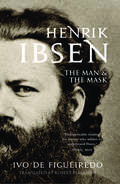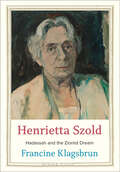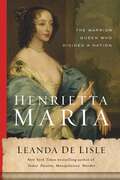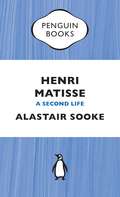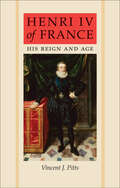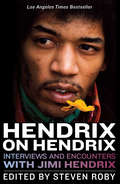- Table View
- List View
Henry David Thoreau: A Life (Science And Literature Ser.)
by Laura Dassow Walls“Walden. Yesterday I came here to live.” That entry from the journal of Henry David Thoreau, and the intellectual journey it began, would by themselves be enough to place Thoreau in the American pantheon. His attempt to “live deliberately” in a small woods at the edge of his hometown of Concord has been a touchstone for individualists and seekers since the publication of Walden in 1854. But there was much more to Thoreau than his brief experiment in living at Walden Pond. A member of the vibrant intellectual circle centered on his neighbor Ralph Waldo Emerson, he was also an ardent naturalist, a manual laborer and inventor, a radical political activist, and more. Many books have taken up various aspects of Thoreau’s character and achievements, but, as Laura Dassow Walls writes, “Thoreau has never been captured between covers; he was too quixotic, mischievous, many-sided.” Two hundred years after his birth, and two generations after the last full-scale biography, Walls restores Henry David Thoreau to us in all his profound, inspiring complexity. Walls traces the full arc of Thoreau’s life, from his early days in the intellectual hothouse of Concord, when the American experiment still felt fresh and precarious, and “America was a family affair, earned by one generation and about to pass to the next.” By the time he died in 1862, at only forty-four years of age, Thoreau had witnessed the transformation of his world from a community of farmers and artisans into a bustling, interconnected commercial nation. What did that portend for the contemplative individual and abundant, wild nature that Thoreau celebrated? Drawing on Thoreau’s copious writings, published and unpublished, Walls presents a Thoreau vigorously alive in all his quirks and contradictions: the young man shattered by the sudden death of his brother; the ambitious Harvard College student; the ecstatic visionary who closed Walden with an account of the regenerative power of the Cosmos. We meet the man whose belief in human freedom and the value of labor made him an uncompromising abolitionist; the solitary walker who found society in nature, but also found his own nature in the society of which he was a deeply interwoven part. And, running through it all, Thoreau the passionate naturalist, who, long before the age of environmentalism, saw tragedy for future generations in the human heedlessness around him. “The Thoreau I sought was not in any book, so I wrote this one,” says Walls. The result is a Thoreau unlike any seen since he walked the streets of Concord, a Thoreau for our time and all time.
Henry Cowell: A Man Made of Music
by Joel SachsJoel Sachs offers the first complete biography of one of the most influential figures in twentieth-century American music. Henry Cowell, a major musical innovator of the first half of the 20th century, left a rich body of compositions spanning a wide range of styles. But as Sachs shows, Cowell's legacy extends far beyond his music. He worked tirelessly to create organizations such as the highly influential New Music Quarterly, New Music Recordings, and the Pan-American Association of Composers, through which great talents like Ruth Crawford Seeger and Charles Ives first became known in the US and abroad. As one of the first Western advocates for World Music, he used lectures, articles, and recordings to bring other musical cultures to myriad listeners and students including John Cage and Lou Harrison, who attributed their life work to Cowell's influence. Finally, Sachs describes the tragedy of Cowell's life, being sentenced to fifteen years in San Quentin -- of which he served four -- after pleading guilty to a morals charge that even the prosecutor felt was trivial. Providing a wealth of insight into Cowell's ideas and philosophy, Joel Sachs lays out a much-needed perspective on one of the giants of twentieth-century American music.
Henry Clay: The Essential American
by David S. Heidler Jeanne T. HeidlerHe was the Great Compromiser, a canny and colorful legislator whose life mirrors the story of America from its founding until the eve of the Civil War. Speaker of the House, senator, secretary of state, five-time presidential candidate, and idol to the young Abraham Lincoln, Henry Clay is captured in full at last in this rich and sweeping biography.David S. Heidler and Jeanne T. Heidler present Clay in his early years as a precocious, witty, and optimistic Virginia farm boy who at the age of twenty transformed himself into an attorney. The authors reveal Clay's tumultuous career in Washington, including his participation in the deadlocked election of 1824 that haunted him for the rest of his career, and shine new light on Clay's marriage to plain, wealthy Lucretia Hart, a union that lasted fifty-three years and produced eleven children.Featuring an inimitable supporting cast including Thomas Jefferson, James Madison, and Abraham Lincoln, Henry Clay is beautifully written and replete with fresh anecdotes and insights. Horse trader and risk taker, arm twister and joke teller, Henry Clay was the consummate politician who gave ground, made deals, and changed the lives of millions.d replete with fresh anecdotes and insights. But it is Henry Clay who often rises above them all. Horse trader and risk taker, arm twister and joke teller, Clay was the consummate politician who gave ground, made deals, and changed the lives of millions. His life is an astounding tale--and here superbly told.From the Hardcover edition.
Henry Clay: Statesman for the Union
by Robert V. ReminiAmong nineteenth-century Americans, few commanded the reverence and respect accorded to Henry Clay of Kentucky. As orator and as Speaker of the House for longer than any man in the century, he wielded great power, a compelling presence in Congress who helped preserve the Union in the antebellum period. Remini portrays both the statesman and the private man, a man whose family life was painfully torn and who burned with ambition for the office he could not reach, the presidency.
Henry Clay: Statesman for the Union (citated)
by Robert V. ReminiRobert V. Remini summed up the sentiment that many people of the antebellum period of U.S. history had about Henry Clay. "Henry Clay was one of the most gifted men of his age. He distinguished himself as a public speaker, a lawyer, a politician, and Speaker of the House of Representatives. He might have made a truly great President" ([PAGE 209 OF THE TEXT]) if he had been given a chance. While praising Henry Clay, Remini also cited evidence that portrayed Clay as a controlling, hot-tempered, and often irrational, and immoral man. At times, people had trouble interacting with him while at other times he was extremely hospitable and friendly. In short, Remini described a man who both clamored for political power and, at the same time, wanted to contribute to the success of the country; that is, he deeply yearned for and acted in a manner that he thought was best for the union while simultaneously believing that he was the most qualified for this difficult task. In this biography, Remini described both the political and personal life of Henry Clay. Through this portrayal, the reader not only gains insight into the personal and political life of Henry Clay, but learns about the historical and cultural aspects of the time. The reader is able to enter into the struggles and conflicts of the age. These conflicts included such aspects as slavery and party politics. Even though this biography is non-fiction, it often reads as a fictional novel. Remini interspersed anecdotes, letters, and other writings into the historical details of the biography to allow the reader to understand the character and personality of Henry Clay and other famous and ordinary people. The biography is replete with numerous footnotes that give the biography authenticity as well as give the reader knowledge about the period and explanations about aspects that might not be understood by non-historians.
Henry Clay: America's Greatest Statesman
by Harlow Giles UngerA compelling new biography of America's most powerful Speaker of the House, who held the divided nation together for three decades and who was Lincoln's guiding light
Henry ‘Chips’ Channon (Volume 2): 1938-43
by Chips ChannonThe second volume of the remarkable, Sunday Times bestselling diaries of Chips Channon.'A masterpiece - a time machine that transports the reader back to British politics and high society at the end of the 1930s.' Robert Harris'The uncensored, unvarnished thought of one of the 20th century's greatest diarists. - Best Biographies of the Year, Telegraph'An unrivalled guide to the social and political life of Britain in the first half of the 20th century.' Books of the Year, The Times'Fascinating.' New Statesman'Never a dull day, never a dull sentence.' Daily Mail_______________________________________________This second volume of the bestselling diaries of Henry 'Chips' Channon takes us from the heady aftermath of the Munich agreement, when the Prime Minister so admired by Chips was credited with having averted a general European conflagration, through the rapid unravelling of appeasement, and on to the tribulations of the early years of the Second World War. It closes with a moment of hope, as Channon, in recording the fall of Mussolini in July 1943, reflects: 'The war must be more than half over.'For much of this period, Channon is genuinely an eye-witness to unfolding events. He reassures Neville Chamberlain as he fights for his political life in May 1940. He chats to Winston Churchill while the two men inspect the bombed-out chamber of the House of Commons a few months later. From his desk at the Foreign Office he charts the progress of the war. But with the departure of his boss 'Rab' Butler to the Ministry of Education, and Channon's subsequent exclusion from the corridors of power, his life changes - and with it the preoccupations and tone of the diaries. The conduct of the war remains a constant theme, but more personal preoccupations come increasingly to the fore. As he throws himself back into the pleasures of society, he records his encounters with the likes of Noël Coward, Prince Philip, General de Gaulle and Oscar Wilde's erstwhile lover Lord Alfred Douglas. He describes dinners with members of European royal dynasties, and recounts gossip and scandal about the great, the good and the less good. And he charts the implosion of his marriage and his burgeoning, passionate friendship with a young officer on Wavell's staff.These are diaries that bring a whole epoch vividly to life.
Henry ‘Chips’ Channon (Volume 1): 1918-38
by Chips ChannonThe Sunday Times bestselling edition of Chips Channon's remarkable diaries.Born in Chicago in 1897, 'Chips' Channon settled in England after the Great War, married into the immensely wealthy Guinness family, and served as Conservative MP for Southend-on-Sea from 1935 until his death in 1958. His career was unremarkable. His diaries are quite the opposite. Elegant, gossipy and bitchy by turns, they are the unfettered observations of a man who went everywhere and who knew everybody. Whether describing the antics of London society in the interwar years, or the growing scandal surrounding his close friends Edward VIII and Wallis Simpson during the abdication crisis, or the mood in the House of Commons in the lead up to the Munich crisis, his sense of drama and his eye for the telling detail are unmatched. These are diaries that bring a whole epoch vividly to life. A heavily abridged and censored edition of the diaries was published in 1967. Only now, sixty years after Chips's death, can an extensive text be shared.________________________________'Chips perfectly embodied the qualities vital to the task: a capacious ear for gossip, a neat turn of phrase, a waspish desire to tell all, and easy access to the highest social circles across Europe.[...] Blending Woosterish antics with a Lady Bracknellesque capacity for acid comment. Replete with fascinating insights.' Jesse Norman, Financial Times
Henry ‘Chips’ Channon: The Diaries (Volume 3): 1943-57
by Chips ChannonThis third and final volume of the unexpurgated diaries of Sir Henry 'Chips' Channon begins as the Second World War is turning in the Allies' favour. It ends with Chips descending into poor health but still able to turn a pointed phrase about the political events that swirl around him and the great and the good with whom he mingles.Throughout these final fourteen years Chips assiduously describes events in and around Westminster, gossiping about individual MPs' ambitions and indiscretions, but also rising powerfully to the occasion to capture the mood of the House on VE Day or the ceremony of George VI's funeral. His energies, though, are increasingly absorbed by a private life that at times reaches Byzantine levels of complexity. We encounter the London of the theatre and the cinema, peopled by such figures as John Gielgud, Laurence Olivier, Vivien Leigh and Douglas Fairbanks Jr, as well as a seemingly endless grand parties at which Chips might well rub shoulders with Cecil Beaton, the Mountbattens, or any number of dethroned European monarchs. He has been described as 'The greatest British diarist of the 20th century'. This final volume fully justifies that accolade.
Henry Cérard: idéaliste détrompé
by Ronald FrazeeHere for the first time is an authoritative account of the life and literary activity of a long-neglected writer of the French naturalist school. Its appearance now is especially timely in view of the recent revival of interest in Zola, Maupassant and Huysmans, and the publication of the complete Goncourt Journals. Cérard's written works were virtually neglected by his contemporaries as well as by most historians of the naturalist movement. However, his novels, short stories, and plays had good critical receptions, and in providing this study of the author, as well as a comprehensive bibliography of all his works, Mr. Frazee is performing a valuable service for students of literature. As an artist Cérard was perhaps less powerful than Zola or Goncourt, but one appreciates, as Mr. Frazee has noted, "la prédominance de l'esprit d'analyse sur l'esprit d'imagination." An important contribution was his early experimental novel Une belle journée; this explored in depth a single day in a character's life, and was the first of a number of such novels, which culminated in Joyce's Ulysses. While attempting to give Cérard his due as an artist Mr. Frazee, in seeking to discover the relations between this paradoxical personality and his work, has not hesitated to point out Cérard's personal failings. Cérard was an intriguing blend of deceptive simplicity and surprising complexity, and he showed a pessimism and resignation, typical of the fin de siècle, which were evidence of the influence of Schopenhauer. Because secondary writers often give a better picture of their times than their better-known contemporaries, this biography, too, is able to shed new light on the last thirty years of the nineteenth century while providing an important guide for today's scholars and the future investigators of an important area of French literature.
Henry Austin: In Every Variety of Architectural Style (Garnet Books)
by James F. O'GormanHenry Austin's (1804-1891) works receive consideration in books on nineteenth-century architecture, yet no book has focused scholarly attention on his primary achievements in New Haven, Connecticut, in Portland, Maine, and elsewhere. Austin was most active during the antebellum era, designing exotic buildings that have captured the imaginations of many for decades. James F. O'Gorman deftly documents Austin's work during the 1840s and '50s, the time when Austin was most productive and creative, and for which a wealth of material exists. The book is organized according to various building types: domestic, ecclesiastic, public, and commercial. O'Gorman helps to clarify what buildings should be attributed to the architect and comments on the various styles that went into his eclectic designs. Henry Austin is lavishly illustrated with 132 illustrations, including 32 in full color. Three extensive appendices provide valuable information on Austin's books, drawings, and his office.
Henry and June: From "A Journal of Love," The Unexpurgated Diary (1931–1932) of Anaïs Nin
by Anaïs NinThis bestseller covers a single momentous year during Nin’s life in Paris, when she met Henry Miller and his wife, June. “Closer to what many sexually adventuresome women experience than almost anything I’ve ever read....I found it a very erotic book and profoundly liberating” (Alice Walker). The source of a major motion picture from Universal. Preface by Rupert Pole; Index.
Henry Alline: 1748-1784
by J. M. BumstedTo Canadians of this century the name of Henry Alline is almost unknown. This biography introduces him to the general reader. Through the story of his life it also recreates the early settlement of the Maritime provinces, and examines the origins of one of the most dominant and continuing themes in Canadian life, evangelical pietism. Henry Alline emigrated from Rhode Island to Nova Scotia with his parents in 1760. Following his religious conversion during adolescence, he became an evangelical preacher and travelled throughout Nova Scotia spreading the gospel. But Alline was more than an itinerant preacher. Drawing on British (and indirectly on German) mythical writings, he rejected the tenets of Calvinism in favour of universal salvation and human free will. He emphasized Christian asceticism and mysticism. His writings, and his attempts to develop an intellectual rationale for his evangelical position, made him Canada's first metaphysical and mystical philosopher.In the history of early British settlement in Nova Scotia the name of Alline stands out because of his participation in the process and problems of settlement and his leadership during the trying times of the American Revolution. His career embodied a rejection of both the United States (by a rejection of Puritanism) and of Britain (by a rejection of church and state in Nova Scotia), and put Alline in a classic Nova Scotia position, neutrality, which could be justified by the importance of Christ and the relative unimportance of government. The years in which Alline lived were particularly critical ones for Canada, and his career both mirrors and dominates a period of pioneer hardships, political crises, and spiritual concern born of the uncertainties of human existence.
Henry Adams: A Biography
by Elizabeth StevensonHenry Brooks Adams was an American historian and member of an elite New England political family, descended from two U.S. Presidents--John Adams and John Quincy Adams. With the publication of his autobiography, "The Education of Henry Adams," in 1907, Henry Adams became the interpreter of his age. His insights and his attacks on the chaos and complexity of modern times stirred people everywhere. Depicting himself as a man seeking the meaning of life, he concluded that the quest ended in failure and predicted universal dissolution. Yet the picture he drew of himself was not complete, and since his death in 1918, he has become one of the most controversial figures in American letters. This is the first biography to give a well-rounded portrait of Adams and to shed a full light on his unique personality and writings.
Henry: Libro Tres de la Trilogía Tudor (DA TRILOGIA TUDOR #3)
by Tony RichesBosworth 1485. Tras su victoria sobre el rey Richard III, Henry Tudor se convierte en rey de Inglaterra. Rebeldes e impostores conspiran para quitarle el trono. Los barones se oponen a los planes de Henry tendientes a disminuir su poder, y él no está seguro de en quién puede confiar. Su deseo es unir las casa de Lancaster y de York a través de su matrimonio con la bella Elizabeth de York. Con la ayuda de su madre, lady Margaret Beaufort, consigue mantener una paz frágil. Escoge una princesa española, Catalina de Aragón, como esposa para su hijo, el príncipe Arthur. Sus hijas se casarán con el rey de Escocia y con el hijo del emperador de Roma. Cuando parece que sus plegarias han sido escuchadas, la tragedia lo golpea y Henry deberá asegurar el futuro de los Tudor.
Henri's Scissors
by Jeanette WinterIn a small weaving town in France, a young boy named Henri-Emile Matisse drew pictures everywhere, and when he grew up, he moved to Paris and became a famous artist who created paintings that were adored around the world. But late in life a serious illness confined him to a wheelchair, and amazingly, it was from there that he created among his most beloved works—enormous and breathtaking paper cutouts. <P><P>Based on the life of Henri Matisse, this moving and inspirational picture book biography includes a note from the author, dynamic quotes from Matisse himself, and an illuminating look at a little-known part of a great artist’s creative process. <P><P>Lexile Measure: AD510L
Henri's Scissors
by Jeanette WinterStep into the colorful world of Henri Matisse and his magnificent paper cutouts in this biography by acclaimed picture book creator Jeanette Winter. <p><p> In a small weaving town in France, a young boy named Henri-Emile Matisse drew pictures everywhere, and when he grew up, he moved to Paris and became a famous artist who created paintings that were adored around the world. But late in life a serious illness confined him to a wheelchair, and amazingly, it was from there that he created among his most beloved works—enormous and breathtaking paper cutouts. <p><p> Based on the life of Henri Matisse, this moving and inspirational picture book biography includes a note from the author, dynamic quotes from Matisse himself, and an illuminating look at a little-known part of a great artist’s creative process.
Henri's Scissors
by Jeanette WinterIn a small weaving town in France, a young boy named Henri-Emile Matisse drew pictures everywhere, and when he grew up, he moved to Paris and became a famous artist who created paintings that were adored around the world. But late in life a serious illness confined him to a wheelchair, and amazingly, it was from there that he created among his most beloved works—enormous and breathtaking paper cutouts. <P><P>Based on the life of Henri Matisse, this moving and inspirational picture book biography includes a note from the author, dynamic quotes from Matisse himself, and an illuminating look at a little-known part of a great artist’s creative process. <P><P>Lexile Measure: AD510L
Henrik Ibsen: The Man and the Mask
by Ivo De FigueiredoA magnificent new biography of Henrik Ibsen, among the greatest of modern playwrights Henrik Ibsen (1820–1908) is arguably the most important playwright of the nineteenth century. Globally he remains the most performed playwright after Shakespeare, and Hedda Gabler, A Doll’s House, Peer Gynt, and Ghosts are all masterpieces of psychological insight. This is the first full-scale biography to take a literary as well as historical approach to the works, life, and times of Ibsen. Ivo de Figueiredo shows how, as a man, Ibsen was drawn toward authoritarianism, was absolute in his judgments over others, and resisted the ideas of equality and human rights that formed the bases of the emerging democracies in Europe. And yet as an artist, he advanced debates about the modern individual’s freedom and responsibility—and cultivated his own image accordingly. Where other biographies try to show how the artist creates the art, this book reveals how, in Ibsen’s case, the art shaped the artist.
Henrietta Szold: Hadassah and the Zionist Dream (Jewish Lives)
by Francine KlagsbrunAward-winning author Francine Klagsbrun reveals the complex life and work of Henrietta Szold, founder of Hadassah and a Zionist trailblazer Henrietta Szold (1860–1945) is renowned as the founder of Hadassah, the Women&’s Zionist Organization of America, which quickly became one of the most successful of all Zionist groups. In her work with Hadassah, Szold used a combined ethical and pragmatic approach aimed at improving the lives of both Jews and Arabs. She later moved to Mandate Palestine to help shape education, health, and social services there. The pinnacle of her career came in her seventies, when she took on the task of directing the Youth Aliyah program, which rescued thousands of young people from the Nazis and resettled them in Palestine. Using Szold&’s copious letters, diaries, and essays, along with other archival documents, Francine Klagsbrun traces Szold&’s life and legacy with an eye to uncovering the person behind the Zionist icon. She reveals Szold as a complex human being who had to cope with controversy and criticism, a workaholic with an outsized sense of duty, and an idealist who fought for her beliefs even as she questioned her own abilities. With deep insight, Klagsbrun introduces readers to this extraordinary woman, whose impact on women&’s lives as well as on education and health systems still resonates.
Henrietta Mears and how she did it!
by Ethel May Baldwin David V. Benson"WE ARE TOO PRONE to forget how many-sided were her strenuous labors during the more than thirty years she spent in alifornia: (1) She was the inspiration and genius of the great Sunday School of the First Presbyterian Church of Hollywood, with its some 6000 members! (2) In that Sunday School she herself for many years taught its now famous college class--and administration and teaching gifts do not very often go together. (3) She was the founder of the Gospel Light Publications, whose literature has done so much to save many Sunday Schools from compromising or destructively liberal Sunday School study books. (4) She saw come into reality her vision of a Bible conference center at Forest Home, where, I think it can be said, a greater work has been done each year in the College Briefing Conference than in any similar gathering since those conferences held at Northfield by Dwight L. Moody. (5) Dr. Mears' own messages at conventions across our entire land brought inspiration and a deeper understanding of the essential task of a Sunday School teacher to unnumbered multitudes."
Henrietta Maria: The Warrior Queen Who Divided a Nation
by Leanda de LisleDispelling the myths around this legendary queen, this biography of Henrietta Maria, queen consort of King Charles I, retells the dramatic story of the English Civil War from the perspective of this dynamic woman.Henrietta Maria is British history&’s most reviled queen consort. Condemned in her lifetime as the "Popish brat of France,&” an adulteress, and a traitor, she remains in popular memory the wife who wore the breeches in her marriage, the woman who turned her husband Catholic (and so caused the English Civil War), and a cruel and bigoted mother. This clear-eyed biography unpicks the myths and considers the story from Henrietta Maria's point of view. A portrait emerges of a woman whose closest friends included Puritans as well as Catholics, who crossed swords with Cardinal Richelieu, and led the anti-Spanish faction at the English court. A witty conversationalist, Henrietta Maria was a patron of the arts and a champion of the female voice, as well as a mediatrix for her persecuted fellow Catholics. During the civil war, the queen's enemies agreed that Charles would never have survived as long as he did without the "She Generalissimo." Seeing events through her gaze reveals the truth behind the claims that she caused the war, explains her estrangement from her son Henry, and diminishes the image of the Restoration queen as an irrelevant crone. In fact, Henrietta Maria rose from the ashes of her husband's failures—a "phoenix queen&”—presiding over a court judged to have had "more mirth&” even than that of the Merry Monarch, Charles II. It is time to look again at this often-criticized queen and determine if she is not, in fact, one of British history's most remarkable women.
Henri Matisse: A Second Life
by Alastair SookeHenri Matisse by Alastair Sooke - an essential guide to one of the 20th century's greatest artists'One January morning in 1941, only a fortnight or so after his seventy-first birthday, the bearded and bespectacled French artist Henri Matisse was lying in a hospital bed preparing to die.'Diagnosed with cancer, the acclaimed painter, and rival of Picasso, seemed to be facing his demise. Then something unexpected happened. After a life-saving operation that left him too weak to paint, and often too frail to even get out of bed, Matisse invented a ground-breaking and effortless new way of making art. The results rank among his greatest work.In an astonishing blaze of creativity, he began conjuring mesmerising designs of dazzling dancers and thrilling tightrope walkers, sensuous swimmers and mythical figures falling from the heavens. His joyful and unprecedented new works were as spontaneous as jazz music and as wondrous as crystal-clear lagoons. Their medium? Coloured paper and scissors.This book, by art critic and broadcaster Alastair Sooke, focuses on Matisse's extraordinary final decade, which he called 'a second life', after he had returned from the grave. Both a biography and a guide to Matisse's 'cut-outs', it tells the story of the valedictory flourish of one of the most important and beloved artists of the twentieth century.Published in time for a major Tate Modern retrospective.'Sooke is an immensely engaging character. He has none of the weighty self-regard that often afflicts art experts and critics; rather he approaches his subjects with a questioning, open, exploratory attitude' Sarah Vine, The Times 'His shows are excellent - clever, lively, scholarly, but not too lecturey; he's very good at linking his painters with the world outside the studio, and at how these artists have affected the world today' Sam Wollaston reviewing 'Modern Masters', GuardianAlastair Sooke is art critic of the Daily Telegraph. He has written and presented documentaries on television and radio for the BBC, including Modern Masters, The World's Most ExpensivePaintings, Treasures of Ancient Rome and, most recently, Treasures of Ancient Egypt. He is a regular reporter for The Culture Show on BBC Two. He is the author of Roy Lichtenstein: How Modern Art was Saved by Donald Duck.
Henri IV of France: His Reign and Age
by Vincent J. PittsVincent J. Pitts chronicles the life and times of one of France’s most remarkable kings in the first English-language biography of Henri IV to be published in twenty-five years. An unwelcome heir to the throne, Henri ruled over a kingdom plagued by religious civil war and political and economic instability. By the end of his reign in 1610 he had pacified his warring country, restored its prosperity, and reclaimed France’s place as a leading power in Europe. Pitts draws upon the rich scholarship of recent decades to tell the captivating story of this pivotal French king. From boyhood, Henri was destined to be leader and protector of the Huguenot movement in France. He served as chief of the Calvinist party and fought for the Huguenot forces in the bloody Wars of Religion before an extraordinary sequence of dynastic mishaps left the Protestant warlord next in line for the French crown. Henri was forced to renounce his faith in support of his claim to the Catholic throne and to unite his deeply divided country. A master of political maneuvering, Henri restored order to a country in the throes of great religious, political, and economic upheaval. He was assassinated in 1610 by a Catholic zealot.Vincent Pitts expertly recounts this history and skillfully untangles its complex set of personalities and events. Pitts engages the vast amount of literature relating to the king himself as well as the large body of recent scholarship on France during this time. The result is a fascinating biography of a French king and a comprehensive history of sixteenth-century France.
Hendrix on Hendrix: Interviews and Encounters with Jimi Hendrix
by Steven RobyThough many books have chronicled Jimi Hendrix's brilliant but tragically brief musical career, this is the first to use his own words to paint a detailed portrait of the man behind the guitar. With selections carefully chosen by one of the world's leading Jimi Hendrix historians, this work includes the most important interviews from the peak of his career, 1966 to 1970. In this authoritative volume, Hendrix recalls for reporters his heartbreaking childhood, his concept of "Electric Church Music" (intended to wash people's souls and give them a new direction), and his wish to be remembered as not just another guitar player. While Hendrix never wrote a memoir, with new transcriptions from European papers, the African American press, counterculture newspapers, radio and TV interviews, and previously unpublished court transcripts, this book gives music fans the next best thing to a Hendrix autobiography.
